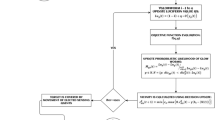Abstract
How to choose the optimal route path finding, enhance the communication capacity of the whole network for wireless sensor networks (WSNs), and prolong the lifetime of the network is a basic problem of WSNs. We draw an inspiration from the single-celled organism-Slime Mold physarum polycephalum of foraging process in this paper, combined with the traditional clustering algorithm to design routing scheme. The application of traditional clustering algorithm and mobile sink technology in WSNs is the basis of this scheme design. The simulation results show that compared with the existing routing protocol, the new scheme can effectively improve the self-adaptation of the network, reduce the energy consumption and improve the overall performance of the network under the complicated network environment.









Similar content being viewed by others
References
Cao N, Liu P, Li G et al (2018) Evaluation models for the nearest closer routing protocol in wireless sensor networks. IEEE Access. https://doi.org/10.1109/ACCESS.2018.2825441
Fan L, Lei X, Yang N, Duong TQ, Karagiannidis GK (2016) Secure multiple amplify-and-forward relaying with cochannel interference. IEEE J Sel Top Signal Process 10(8):1494–1505
Fan L, Lei X, Yang N, Duong TQ, Karagiannidis GK (2017) Secrecy cooperative networks with outdated relay selection over correlated fading channels. IEEE Trans Veh Technol 66(8):7599–7603
Gupta B, Agrawal DP, Yamaguchi S (2016) Handbook of research on modern cryptographic solutions for computer and cyber security. IGI Global, Hershey
He P, Deng Z, Gao C, Wang X, Li J (2017) Model approach to grammatical evolution: deep-structured analyzing of model and representation. Soft Comput 21(18):5413–5423
Heinzelman WB, Chandrakasan AP, Balakrishnan H (2002) An application-specific protocol architecture for wireless microsensor networks. IEEE Trans Wirel Commun 1(4):660–670
Houbraken M, Demeyer S (2013) Fault tolerant network design inspired by Physarum polycephalum. Nat Comput 12(2):277–289
Konstantopoulos C, Pantziou G (2012) A rendezvous-based approach enabling energy-efficient sensory data collection with mobile sinks. IEEE Trans Parallel Distrib Syst 23(5):809–817
Kropat E, Meyernieberg S (2014). Slime mold inspired evolving networks under uncertainty (SLIMO). In: Hawaii international conference on system sciences, pp 1153–1161
Kropat E, Meyernieberg S (2016) A multi-layered adaptive network approach for shortest path planning during critical operations in dynamically changing and uncertain environments, pp 1369–1378
Li K, Thomas K (2010) Slime mold inspired path formation protocol for wireless sensor networks. Lect Notes Comput Sci 6234:299–311
Li K, Thomas K, et al. (2008) Slime mold inspired protocol for wireless sensor networks. In: IEEE international conference on self-adaptive and self-organizing systems, pp 319–328
Nakayama H, Fadlullah ZM, Ansari N (2011) A novel scheme for WSAN sink mobility based on clustering and set packing techniques. IEEE Trans Autom Control 56(10):2381–2389
Nakagaki T, Tero A, Kobayashi R (2008) Computational ability of cells based on cell dynamics and adaptability. New Gener Comput 27(1):57–81
Nakagaki T, Yamada H, Tóth A (2000) Maze-solving by an amoeboid organism. Nature 407(6803):470
Plageras AP, Stergiou C, Psannis KE (2017) Efficient IoT-based sensor BIG data collection-processing and analysis in smart buildings. Future Gener Comput Syst 82:349–357
Rappaport TS (1996) Wireless communications: principles & practice. DBLP, New Jersey
Sarma HKD, Rai P, Deka B (2014) Energy efficient communication protocol for wireless sensor networks with mobile node. In: Recent advances and innovations in engineering, pp 1–6
Shah RC, Roy S, Jain S, Brunette W (2003) Data MULEs: modeling a three-tier architecture for sparse sensor networks. Ad Hoc Netw 1(2–3):215–233
Song Y, Liu L, Ma H (2012) A physarum-inspired algorithm for minimal exposure problem in wireless sensor networks. In: Wireless communications and networking conference, pp 2151–2156
Tero A, Kobayashi R, Nakagaki T (2007) A mathematical model for adaptive transport network in path finding by true slime mold. J Theoret Biol 244(4):553
Tero A, Takagi S, Saigusa T (2010) Rules for biologically inspired adaptive network design. Science 327(5964):439–42
Wang H, Wang W, Cui Z, Zhou X, Zhao J, Li Y. A new dynamic firefly algorithm for demand estimation of water resources. Inf Sci. https://doi.org/10.1016/j.ins.2018.01.041
Acknowledgements
This study was funded by National Natural Science Foundation of China under Grant No. 61462028; Jiangxi Provincial Cultivation Program for Academic and Technical Leaders of Major Subjects under Grant No. 20172BCB22017.
Author information
Authors and Affiliations
Corresponding author
Ethics declarations
Conflict of interest
All authors declare that they have no conflict of interest.
Ethical approval
This article does not contain any studies with animals performed by any of the authors, or any studies with human participants or animals performed by any of the authors.
Additional information
Communicated by B. B. Gupta.
Publisher's Note
Springer Nature remains neutral with regard to jurisdictional claims in published maps and institutional affiliations.
Rights and permissions
About this article
Cite this article
Jiang, N., Cheng, Y., Zhou, J. et al. Toward biology-inspired solutions for routing problems of wireless sensor networks with mobile sink. Soft Comput 22, 7847–7855 (2018). https://doi.org/10.1007/s00500-018-3506-1
Published:
Issue Date:
DOI: https://doi.org/10.1007/s00500-018-3506-1




